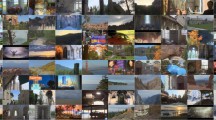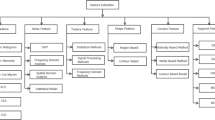Abstract
With the rapid development of visual digital media, the demand for better quality of service has increased the pressure on broadcasters to automate their error detection and restoration activities for preserving their archives. Digital dropout is one of the defects that affect archived visual materials and tends to occur in block by block basis (size of 8 × 8). It is well established that human visual system (HVS) is highly adapted to the statistics of its visual natural environment. Consequently, in this paper, we have formulated digital dropout detection as a classification problem which predicts block label based on statistical features. These statistical features are indicative of perceptual quality relevant to human visual perception, and allow pristine images to be distinguished from distorted ones. Here, the idea is to extract discriminant block statistical features based on discrete cosine transform (DCT) coefficients and determine an optimal neighborhood sampling strategy to enhance the discrimination ability of block representation. Since this spatial frame based approach is free from any motion computation dependency, it works perfectly in the presence of fast moving objects. Experiments are performed on video archives to evaluate the efficacy of the proposed technique.











Similar content being viewed by others
References
Bachman R, Laurenson P, Weaver H, Van Bogart J, Inc SA (n.d.) Preservation Glossary. http://www.bavc.org/preservation/resources/preservation-glossary#data, [Online; accessed 14-September-2014]
Bae HJ, Jung SH (1997) Image retrieval using texture based on dct. In: Proceedings of 1997 international conference on information, communications and signal processing, ICICS. IEEE, pp 1065–1068
Balam S, Schonfeld D (2006) Associative processors for video coding applications. IEEE Trans Circ Syst Video Technol 16(2):241–250
Barlow H (2001) Redundancy reduction revisited. Netw Comput Neural Syst 12(3):241–253
Bovik AC, Clark M, Geisler WS (1990) Multichannel texture analysis using localized spatial filters. IEEE Trans Pattern Anal Mach Intell 12(1):55–73
Brandão T, Queluz MP (2008) No-reference image quality assessment based on dct domain statistics. Signal Process 88(4):822–833
Cho NI, Lee SU (1991) Fast algorithm and implementation of 2-d discrete cosine transform. IEEE Trans Circ Syst 38(3):297–305
Digigram (n.d.) BROADCAST–VX 222. http://www.digigram.com/products/product_infos.php?prod_key=10850, [Online; accessed 14-September-2014]
Eom M, Choe Y (2005) Fast extraction of edge histogram in dct domain based on mpeg7. In: Proceedings of world academy of science, engineering and technology, vol 9, pp 209–212
Farrugia RA, Debono CJ (2007) Enhancing the error detection capabilities of dct based codecs using compressed domain dissimilarity metrics. In: Proceedings of the international conference on computer as a tool, EUROCON 2007. IEEE, pp 1091–1095
Farrugia RA, Debono CJ (2009) A support vector machine approach for detection and localization of transmission errors within standard h. 263++ decoders. IEEE Trans Multimed 11(7):1323–1330
Gabarda S, Cristóbal G (2007) Blind image quality assessment through anisotropy. JOSA A 24(12):B42–B51
Geisler WS (2008) Visual perception and the statistical properties of natural scenes. Annu Rev Psychol 59:167–192
Haque M (1985) A two-dimensional fast cosine transform. IEEE Trans Acoust Speech Signal Process 33(6):1532–1539
Hoque MM, Pimentel MLQ, Hasan MM, Ahn K, Kim J, Chae O (2014) Edge-based spatial concealment of digital dropout error in degraded archived media. Electron Lett 50(14):996–997
Hsu CW, Lin CJ (2002) A simple decomposition method for support vector machines. Mach Learn 46(1-3):291–314
ITU-T RECOMMENDATION P, 1999 Subjective video quality assessment methods for multimedia applications
Kaprykowsky H, Liu M, Ndjiki-Nya P (2009) Restoration of digitized video sequences: an efficient drop-out detection and removal framework. In: 16th IEEE international conference on image processing (ICIP), 2009. IEEE, pp 85–88
Khan E, Lehmann S, Gunji H, Ghanbari M (2004) Iterative error detection and correction of h. 263 coded video for wireless networks. IEEE Trans Circ Syst Video Technol 14(12):1294–1307
Kokaram AC (2004) On missing data treatment for degraded video and film archives: a survey and a new bayesian approach. IEEE Trans Image Process 13(3):397–415
Kokaram AC, Morris RD, Fitzgerald WJ, Rayner PJ (1995) Detection of missing data in image sequences. IEEE Trans Image Process 4(11):1496–1508
Kung WY, Kim CS, Kuo CC (2006) Spatial and temporal error concealment techniques for video transmission over noisy channels. IEEE Trans Circ Syst Video Technol 16(7):789–803
Lee SW, Kim YM, Choi SW (2000) Fast scene change detection using direct feature extraction from mpeg compressed videos. IEEE Trans Multimed 2(4):240–254
Ma L, Li S, Zhang F, Ngan KN (2011) Reduced-reference image quality assessment using reorganized dct-based image representation. IEEE Trans Multimed 13(4):824–829
Optibase (n.d.) Optibase–MGW 230. http://helpdesk.optibase.com/MGW230/, [Online; accessed 14-September-2014]
Peli E (1990) Contrast in complex images. JOSA A 7(10):2032–2040
Saad MA, Bovik AC, Charrier C (2010) A dct statistics-based blind image quality index. IEEE Sig Process Lett 17(6):583–586
Saad MA, Bovik AC, Charrier C (2011) Dct statistics model-based blind image quality assessment. In: Proceedings of 18th IEEE international conference on image processing (ICIP), 2011. IEEE, pp 3093–3096
Saad MA, Bovik AC, Charrier C (2012) Blind image quality assessment: a natural scene statistics approach in the dct domain. IEEE Trans Image Process 21(8):3339–3352
Van der Schaar M, Turaga DS, Wong R (2006) Classification-based system for cross-layer optimized wireless video transmission. IEEE Trans Multimed 8(5):1082–1095
Sheikh HR, Bovik AC (2006) Image information and visual quality. IEEE Trans Image Process 15(2):430–444
Shen B, Sethi IK (1996) Direct feature extraction from compressed images. In: Electronic imaging: science & technology international society for optics and photonics, pp 404–414
Sokolova M, Lapalme G (2009) A systematic analysis of performance measures for classification tasks. Inf Process Manag 45(4):427–437
Sun SF, Han S, Wang G, Yc X, Lei BJ (2010) Mosaic defect detection in digital video. In: 2010 Chinese Conference on Pattern Recognition (CCPR). IEEE, pp 1–5
Video M (n.d.) Matrox DSX hardware components. http://www.matrox.com/video/en/solutions/developer/dsx/, [Online; accessed 14-September-2014]
Wang Z, Bovik AC, Sheikh HR, Simoncelli EP (2004) Image quality assessment: from error visibility to structural similarity. IEEE Trans Image Process 13(4):600–612
Acknowledgments
The authors wish to thank Korean Broadcasting System (KBS), South Korea for providing the video archives.
Author information
Authors and Affiliations
Corresponding author
Rights and permissions
About this article
Cite this article
Hoque, M.M., Song, G., Ahn, K. et al. DCT statistics-based digital dropout detection in degraded archived media. Multimed Tools Appl 75, 4259–4283 (2016). https://doi.org/10.1007/s11042-015-2469-9
Received:
Revised:
Accepted:
Published:
Issue Date:
DOI: https://doi.org/10.1007/s11042-015-2469-9




